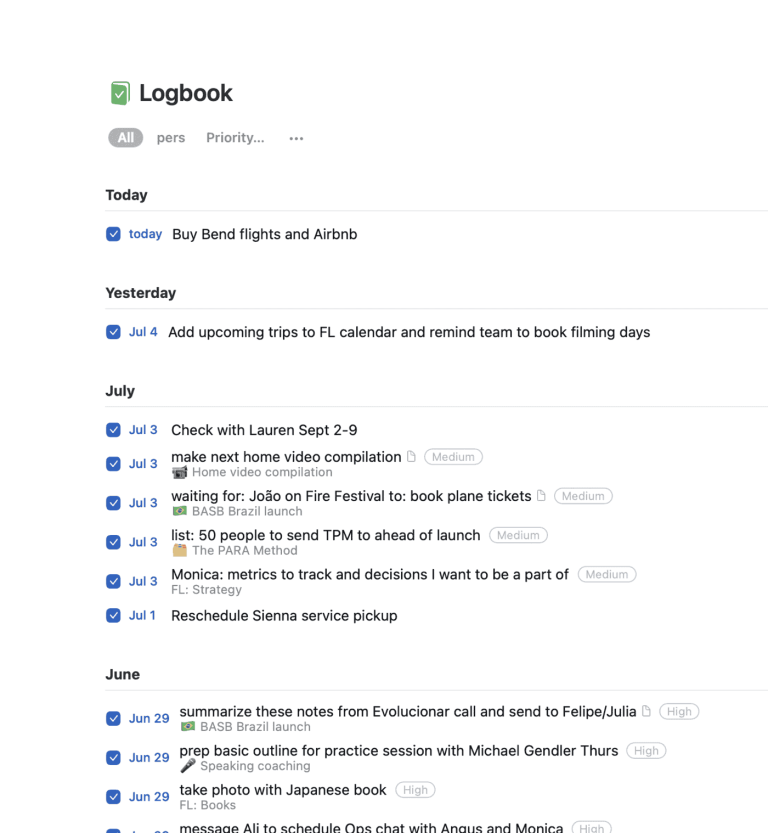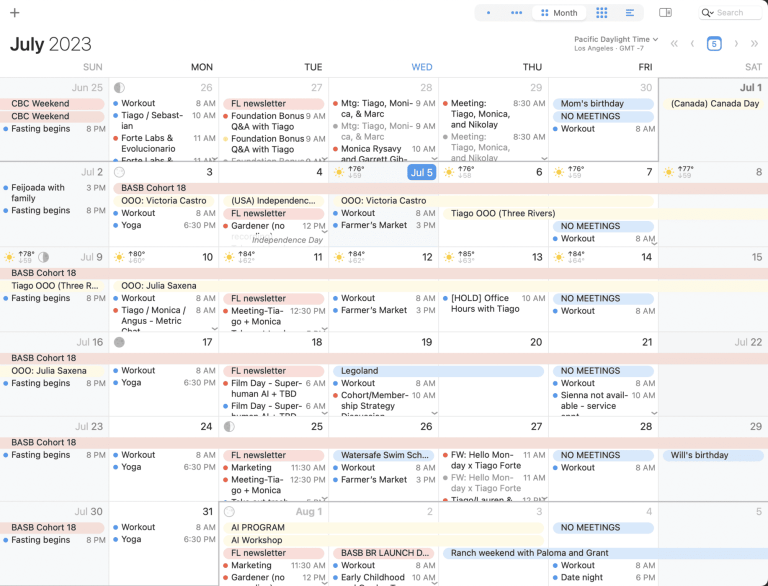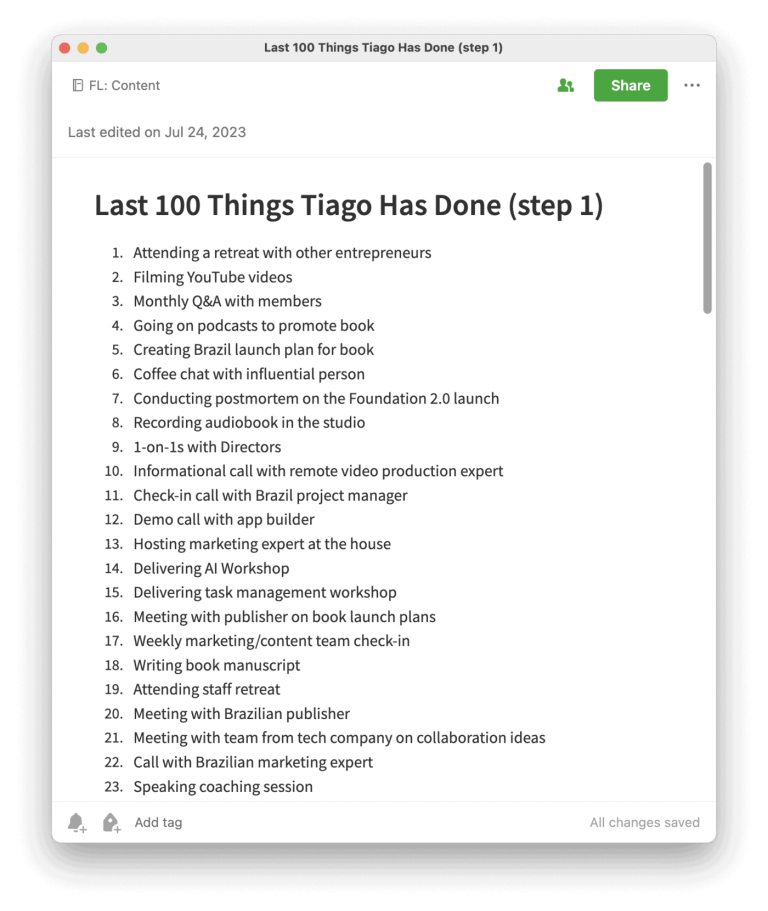I recently completed one of the most powerful exercises I’ve ever invented for delegating aspects of my work to others.
After hosting an insightful weekend retreat with other founders last month, some of whom had significantly larger businesses than mine, I realized I was ready to take a major step I’d been contemplating for some time: asking our COO Monica to take over the day-to-day running of the business.
We had been moving in this direction for quite a while, turning over one part of the company after another to her oversight. Now it was time to make the final leap, moving my last two direct reports to her and stepping back from the operational details to focus on new creative projects.
I’ve always struggled with delegation. Seeing myself mainly as a “doer” and “executor,” it has always felt like I could complete any given task twice as fast as it would take to explain to anyone else. It has always felt strange asking someone else to do something I’m unwilling or unable to do, even if I’m paying them to do exactly that!
Delegation might seem like a narrow topic relevant only to founders and CEOs with the benefit of teams reporting to them, but I don’t think that’s the case. We all have to delegate responsibilities to others, though we might not always call it that.
If you’re a leader of any kind – a people manager, product manager, team lead, or community leader – you need to understand how to organize the work of others. At home, you’ll need to ask your spouse or kids or a housekeeper to handle some things if you don’t want to spend all your time doing chores.
Even individual contributors at work subtly assign follow-up tasks to their colleagues, both junior and senior to them, in order to get what they need. And even AI can be seen as a personal assistant who, despite being very enthusiastic and quick, is also tone-deaf and needs quite a bit of guidance to get it right.
Delegation to all these third parties is a skill and not one that is taught in any school. It requires you to take a moment and think about why something is being done in the first place, what success looks like, what context or details are needed, and who is the best person to handle it.
It’s so much easier to just individualistically plow through another batch of tasks rather than face the challenging question, “Is there someone else who could handle this instead of me?”
Unless you learn to ask and answer this question effectively, you’ll never get the chance to elevate your perspective to higher, more long-term, and more transformational frontiers. You’ll always be stuck at the task level, which isn’t where your vision of the future resides.
The Last 100 is an exercise in learning to leverage other people’s skills, knowledge, and experience to accomplish what you can’t do alone.
The Last 100 Exercise
I woke up one morning with the idea for this exercise in mind and completed it in about 30 minutes. By the time I was finished, I had incredible clarity about what was important for me to do, what wasn’t, and how to tangibly delegate responsibilities that no longer made sense for me.
Here are the four steps I followed.
Step 1: List the last 100 tasks and meetings you completed
The Last 100 is based on a simple observation: it is much easier and more concrete to consider how to delegate tasks you’ve already done in the past, versus speculating on tasks you may do in the future.
Often our recurring duties and habits are so ingrained and invisible, we don’t even fully realize we’re doing them. Rather than try to imagine or guess what tasks I might be able to delegate in the future, I found it much more helpful to look at what I’d already done.
I looked in two places: my task manager (I use an app called Things, which has a “logbook” where every task I’ve checked off is recorded) and my calendar (I use Busycal, an app on my computer and smartphone that connects to Google Calendar). These two software programs are the most comprehensive record of to-do’s I’ve completed, meetings I’ve attended, and calls I’ve made.


Starting with the present day, I moved backward through time in each of these apps, writing down everything I had done in my notes app, Evernote. I had to go back about 3-4 months to find 100 unique items (there’s not much point in writing down duplicates of the same kind of task).
Often when considering delegating something, it’s easy to tell ourselves “Oh but that doesn’t take much time” or “I’ll just make an exception this time and do it myself.” Once I saw the cumulative toll of all these “exceptions” I could no longer deny that a huge proportion of my time was being taken up by minutiae that someone else could easily handle.
Here’s the initial list I came up with (and a link to view the full note):

Step 2: Assign items to others
The next step was to sort these 100 items into buckets based on who I thought was best suited to taking them over. In all, 60 of the last 100 tasks I’d completed myself could easily be delegated to someone else on the team (view full note):

Here’s the breakdown:
- 4 tasks to our YouTube GM and his team
- 9 tasks to our COO and Operations team
- 23 tasks to our Marketing/Content Director and her team
This exercise also revealed several new roles that we could recruit:
- 3 tasks to a volunteer from our alumni student community
- 8 tasks to a freelance writer-editor
- 17 tasks to a part-time personal assistant
There were another 8 tasks that were duplicates and could be deleted. Which left 35 tasks that I didn’t think someone else could do on my behalf.
Step 3: Divide the remaining tasks into 3 groups
Next, I subdivided this remaining list of 35 items into three groups:
- Things I shouldn’t do at all
- Things I think I should do
- Things I want to do
For six items, I realized that if no one could do them for me, then they shouldn’t be done at all. Most of these involved meeting with people to see a demo of a product, learn about their app or startup, or have them “pick my brain.”
I put them all on a “Do not do” list as a reminder that I regretted doing them after the fact, which meant I’d probably regret committing to them in the future:
- Coffee chat with influential person
- Demo call with app builder
- Call with interesting entrepreneur
- Share AI-generated BASB images with team and solicit ideas for how to use them
- Call with KM manager for info on organizational KM
- Call with app founder
I identified another 18 items as “shoulds,” not wants. They are “necessary evils” that don’t give me energy or joy, but that seem to be essential for unblocking or enabling other things that do give me joy. In the future I’ll do my best to avoid or minimize them as much as possible:
- Fix Readwise syncing
- Read and provide feedback on book proposal from a fellow creator
- Write captions for BASB 1-year anniversary slideshow
- Host marketing expert at the house
- Meet with publisher on book launch plans
- Meet with team from tech company on collaboration ideas
- Off-site interview in LA
- Going on podcasts to promote book
- Meeting with Brazilian publisher
- Deliver session at SB Summit
- Practice SB Summit presentation
- Email course creator proposing video collab
- Call with notetaking app PM
- Meet with tech company PM
- Try new AI feature in Photoshop
- Write up details needed by lawyer in legal dispute
- Call with lawyer to discuss legal dispute
- Review agenda for retreat and make adjustments/ask questions
And finally, as the final result of this experiment, I was left with 15 items that only I can do, and that I want to do. These items fall within my “zone of genius” – I am both uniquely capable of doing them, and they also give me a lot of satisfaction and pleasure. These are the frontiers where my time and attention are best utilized and have the best chance of transforming the business:
- Writing book manuscript
- Business coaching session with Mina
- Write blog post
- Record audiobook in the studio
- Host a retreat with other entrepreneurs
- Product launch kickoff meeting
- Speaking coaching session
- Film YouTube videos
- Record audio for voiceovers for YT videos
- Run Q&A with cohort facilitators
- Record video selfie for cohort CTA
- Deliver AI Workshop
- Conduct Monthly Q&A with members
- Read books for ideas
- Edit/refine Foundation sales email series
Interestingly, they seem to fall within 4 main categories:
- Creating new things (writing, recording, filming, teaching)
- Working with experts and peers (my business coach, fellow entrepreneurs, speaking coach, cohort facilitators)
- Inspiring and guiding the team (for product launches and retrospectives for example)
- Sales (making direct calls to action, drafting sales emails with personal stories)
Step 4: Share what you’ve discovered
None of this is of any use if you don’t share it with anyone. The entire point of this exercise is to change your working relationships, and that begins with transparently communicating to colleagues what you’ve learned from taking the steps above.
I shared my lists with the team and asked them to support me in delegating the 85% of my current duties that are not the best use of my talents and that don’t advance our business or our mission.
To my surprise, they were more than happy to do so! We have some work to do to give everyone the context, autonomy, and feedback they need to be able to move these kinds of responsibilities forward. But I’m confident we’ll do so, as it is in all our interest for me to spend the maximum percentage of my time fully utilizing my skills, exploring new creative frontiers, and uncovering new opportunities that might very well become the future of our work.
Follow us for the latest updates and insights around productivity and Building a Second Brain on Twitter, Facebook, Instagram, LinkedIn, and YouTube. And if you’re ready to start building your Second Brain, get the book and learn the proven method to organize your digital life and unlock your creative potential.
- POSTED IN: Attention, Entrepreneurship, Personal growth, Productivity, Project management, Self-tracking, Strategy, Workflow
